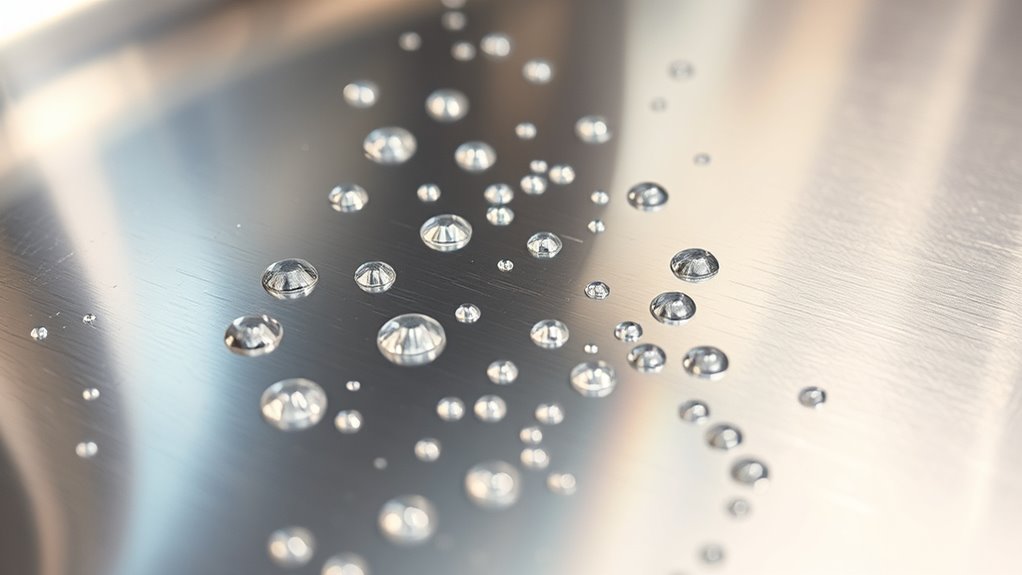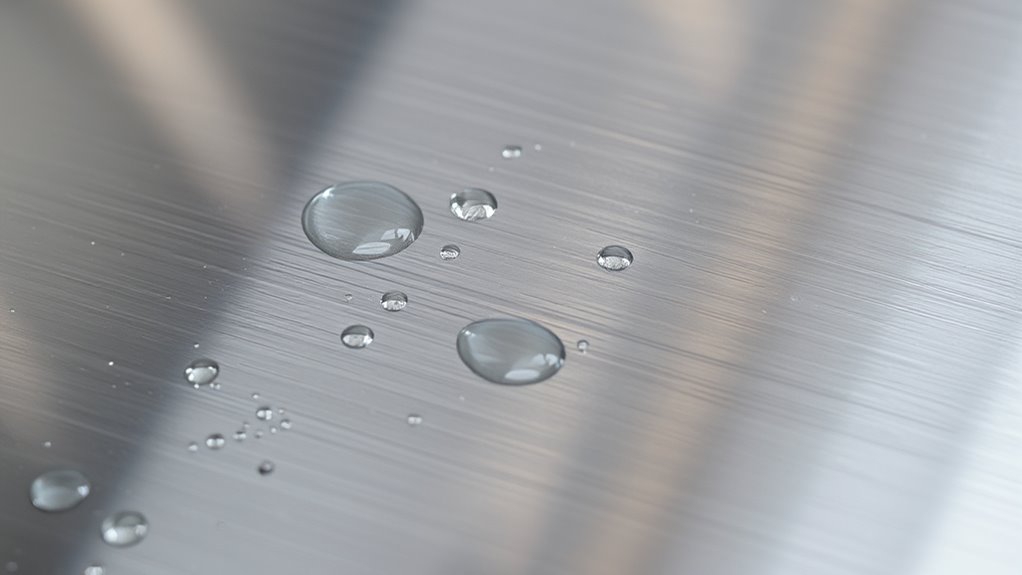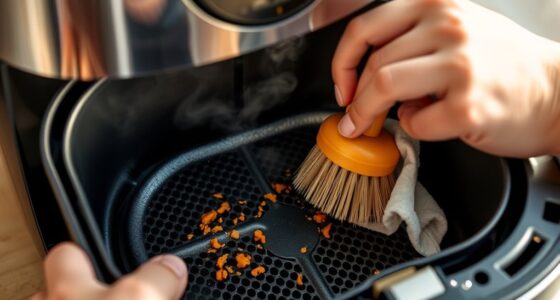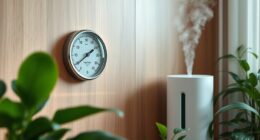To beat mineral water spots on stainless steel without scratches, spray a mixture of white vinegar and water onto the affected area. Let it sit for a few minutes to dissolve the deposits, then wipe gently with a soft cloth or microfiber pad in circular motions. Afterward, buff the surface with a clean, dry cloth and consider applying a stainless steel polish or mineral oil for extra shine. Keep your surface dry afterward to prevent future spots—more tips await if you keep exploring.
Key Takeaways
- Use a vinegar and water solution to dissolve mineral deposits gently without scratching the stainless steel surface.
- Apply a microfiber cloth or soft polishing pad with circular motions to buff out spots and restore shine.
- Wipe surfaces dry after cleaning or water exposure to prevent mineral buildup and future water spots.
- Incorporate stainless steel-specific cleaners or mineral oils to maintain a glossy, scratch-free finish.
- Regularly clean and dry surfaces to prevent mineral deposits from re-forming and extend the appliance’s lifespan.

Stainless water spots are a common nuisance that can mar the sleek appearance of your appliances and fixtures. These spots are often caused by mineral deposits left behind when water evaporates, leaving behind tiny, stubborn residues that dull the shiny surface. Fortunately, you can restore your stainless steel’s luster without resorting to harsh scrubbing or risking scratches. The key lies in effective polishing techniques combined with proper mineral removal methods.
To start, it’s important to understand that the mineral deposits are what create those unsightly spots. These deposits are typically made up of calcium, magnesium, and other minerals dissolved in your water. When water dries on your stainless steel surfaces, these minerals are left behind, forming a crust that’s difficult to wipe away with regular cleaning. To combat this, you need to focus on mineral removal that dissolves these deposits gently but effectively. Using a mixture of white vinegar and water is one of the easiest and safest methods. Simply spray or dab the solution onto the affected area, let it sit for a few minutes, and then wipe clean with a soft cloth. The acidity of vinegar breaks down the mineral buildup, making it easier to polish away without scratching.
Once the minerals are loosened and removed, you want to focus on polishing techniques that restore the shine. Use a microfiber cloth or a soft polishing pad to buff the surface gently. Circular motions work best for spreading the cleaner evenly and bringing out the natural sheen. For extra shine, you can apply a small amount of mineral oil or stainless steel polish after cleaning. These products fill in tiny imperfections and give your appliances a smooth, glossy finish. Remember, the goal is to clean thoroughly and polish lightly—aggressive scrubbing can create scratches that become more noticeable over time.
Regular maintenance is also essential in preventing future water spots. Always wipe down your stainless steel fixtures and appliances after cleaning or exposure to water. Keeping the surface dry prevents mineral deposits from settling and hardening. If you notice persistent spots, repeat the vinegar treatment or consider using a commercial stainless steel cleaner designed for mineral removal. Additionally, incorporating lifestyle habits such as using water softeners or installing water filters can significantly reduce mineral content in your water, making it easier to keep your surfaces spotless. With consistent care and the right polishing techniques, you’ll keep your surfaces looking pristine and free of water spots, maintaining the sleek, mirror-like finish you love.
Frequently Asked Questions
Can Stainless Steel Water Spots Damage the Finish Over Time?
Yes, stainless steel water spots can cause finish deterioration over time if left untreated. Mineral buildup can lead to surface etching, which damages the finish and makes it more vulnerable to scratches. To prevent this, regularly clean your stainless steel with gentle solutions and avoid abrasive scrubbers. This way, you protect the surface from long-term damage and keep your appliance looking shiny and new.
Are There Eco-Friendly Methods to Remove Water Spots?
Yes, there are eco-friendly cleaning methods for removing water spots. You can use natural stain removal techniques like mixing equal parts white vinegar and water or creating a paste with baking soda and water. These solutions are safe and effective, helping you avoid harsh chemicals while restoring your stainless steel’s shine. Always test a small area first, and gently wipe with a soft cloth to prevent scratches.
How Often Should I Clean My Stainless Steel to Prevent Spots?
You should clean your stainless steel surface at least once a week to prevent water spots. Incorporate regular maintenance routines, like wiping with a soft cloth and a gentle cleaner, to keep it spotless and mineral-free. More frequent cleaning might be necessary if you notice spots or fingerprints. Consistent cleaning helps maintain its shine and prevents mineral buildup, ensuring your stainless steel stays looking pristine and free from scratches.
Do Water Spots Affect the Corrosion Resistance of Stainless Steel?
Water spots can increase the corrosion risk on your stainless steel by promoting mineral buildup, which can lead to pitting or rust over time. Although stainless steel is highly resistant, persistent mineral deposits and water spots may weaken its protective layer. To prevent this, regularly clean and dry your stainless steel surfaces, especially after exposure to hard water, to minimize mineral buildup and maintain its corrosion resistance.
What Are the Best Products for Removing Stubborn Water Spots?
For stubborn water spots, you should use products with proven effectiveness like white vinegar or a commercial stainless steel cleaner. Apply the cleaner, let it sit for a few minutes, then gently scrub with a soft cloth or non-abrasive pad. Removal techniques include wiping in the direction of the grain to prevent scratches. These methods guarantee mineral deposits are removed effectively without damaging your stainless steel surface.
Conclusion
So, next time you marvel at your spotless stainless steel, remember those stubborn water spots. Turns out, fighting minerals with harsh scrubbing might just leave your surface more scratched than spotless. Ironically, a gentle touch and patience could be your best allies. After all, sometimes the simplest solutions—like wiping with a soft cloth—are the most effective. So, embrace the spots—they’re a tiny reminder that perfection often comes with a little imperfection.








